|
Following
Gandhi's Path - Part 9
Gandhi
in Mumbai and Poona
By Jan
Oberg
TFF director
Thirty policemen, armed to the teeth, arrested Gandhi
on the 4th of May 1930 when he extracted salt in the
village of Karadhi, near Dandi. He was taken to Yeravda
Prison in Poona. It was not the last time he was thrown
into jail in this part of India.
Between 1917 and 1932, Mumbai/Bombay and Poona (a 4
hours train journey inland) were important places in
Gandhi's long struggle for peace (including Ahmedabad).
In Poona he was also imprisoned in the Aga Khan palace,
since he had returned empty-handed from the negotiations
in London and on New Year's Eve 1931-32 initiated a
non-violence action for Independence. At midnight,
between the 3rd and 4th January, he was arrested on the
roof (where he was sleeping) of his house in Mumbai,
which is now a beautiful Gandhi museum - "Mani Bhavan" -
at No. 19 Liburnum Road.
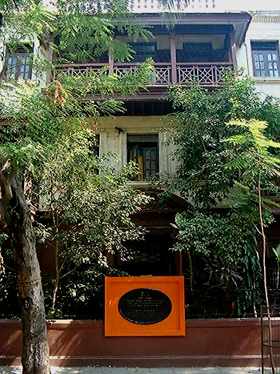
Photo Jan Öberg, © TFF
2001
Mani Bhavan, 19 Liburnum Rd,
Mumbai/Bombay
In Mumbai he learned how to spin and drink goat's
milk. He initiated strikes against English laws, started
one of his many newspapers and worked as a social worker.
In 1934, he decided that he would stop paying membership
fees to the Congress Party and concentrate upon the
situation of the Untouchables. In 1942, in a square in
Mumbai, he started the all-Indian, "Quit India" campaign
directed against the British. For this he was imprisoned
again on the 9th of August and interned in the Aga Khan
Palace together with his wife Kasturba, his secretary and
close friend Mahadev Desai. Desai died a few days after
the internment; Kasturba died in Gandhi's arms in
February 1944. Gandhi was released first, on the 6th of
May 1944.
The "Mani Bhavan" Museum, a wonderful big villa on a
quiet street in Mumbai visited by some 200-300 people
every day, became my oasis. They have a little shop that
sells Gandhi stamps and books, as well as a library with
50,000 volumes which visitors are free to read or borrow.
There is also a research institute with conference rooms.
All of the walls are covered with pictures, original
documents, letters, photographs, etc. - intimate,
informative and meditative. There are small balconies
onto which people can go out and reflect in the shade of
the surrounding, high trees.
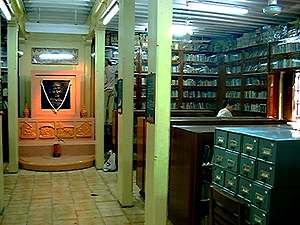
Photo Jan Öberg, © TFF
2001
Mani Bhavan's Library
Gandhi himself lived on the second floor and his
simple workroom looked pretty much the same as the one he
had in Birla House in Delhi, with just a few important
differences. Here he had a telephone! In addition, there
is an oil painting and a statue of Gandhi.
Mani Bhavan is a must for those who want to follow
Gandhi's steps.
The same goes for the Aga Khan Palace in Poona, which
however is somewhat less well-kept. Palaces are expensive
to maintain and the Indian government has reduced their
funding to the Gandhi museums. Gandhi's room is quite
big, with an elegant bathroom and a view overlooking a
wonderful park. It feels much more like a hotel room than
a prison. There is also a memorial grove for Kasturba and
another one for Desai.
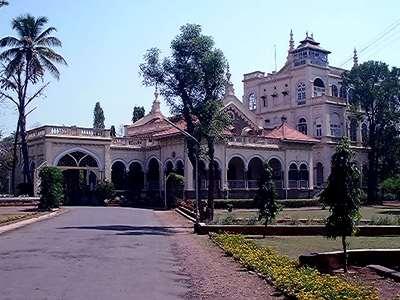
Photo Jan Öberg, © TFF
2001
Aga Khan Palace,
Poona
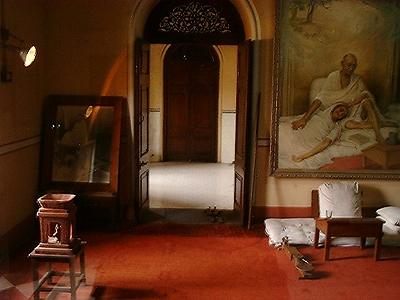
Photo Jan Öberg, ©
TFF 2001
Gandhi's room in the Aga Khan
Palace
I met Gandhi activists and people from the Jesuit
Seminary of the town who intend to repair the palace and
equip it with a conference hall, a lecture room, a
library and an ecological garden in the park.
Upon arriving in Poona, I decided to go and see
Yeravda Prison where Gandhi was held upon several
occasions, just as in Nehru and Desai. But it is not open
to the public. The fortress, built by the British, now
houses 3,400 prisoners of all kinds. Local Gandhi
activists have been detained here because of their
demonstrations - the latest during Clinton's visit.
I knocked on the door of the prison together with
Poona's only peace researcher, Delia Maria Thomas. We
then had to visit different departments of the
unbelievable prison bureaucracy and finally received an
affirmative paper.
We were escorted through a picturesque prison garden
surrounded by small cottages, with a giant mango tree in
the middle. I asked jokingly if I could get interned here
for a couple of days because it all looked so nice. The
garden is well-swept, everything is newly painted and
there are fresh flowers everywhere.
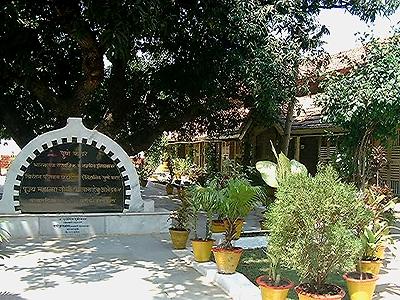
Photo Jan Öberg, © TFF
2001
The Mango Tree in the prison
yard
The mango tree is famous. The English suggested, in
1932, that the India constitution should contain a
provision for the positive, special treatment of the
Untouchables; they should have their own electorate.
Gandhi protested. He intended to fast until death against
this proposition, lying on an iron bedstead under the
mango tree. He saw the matter from a religious and moral
aspect, not from a political. This reorganisation would
sharpen the divisions among Hindus. The British wanted to
give the Untouchables greater influence, but in Gandhi's
opinion the proposition would only entrench their
position as Untouchables, and thus make the abolishment
of the caste system even more difficult. The religious
Gandhi wished to see a secularised India, where everyone
would be treated justly.
The conflict was settled in the "Yeravda Pact", in
which the almost dying Gandhi succeeded in convincing Dr.
Ambedkar, leader of the Untouchables, of his principles.
The entire population of India now rose up against the
British.
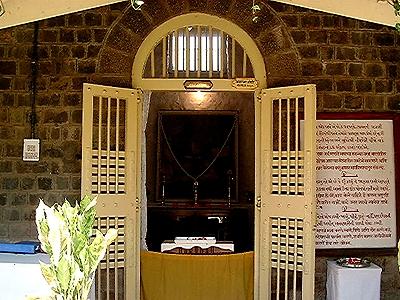
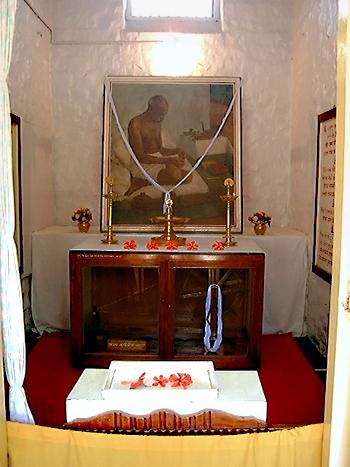
Photo Jan Öberg, © TFF
2001
Gandhi's cell in Yeravda
prison
As usual, Gandhi was most interested in an overall
solution. He maintained that the "means are goals in the
making".
I, myself, wonder what Gandhi would have thought of
today's minority and human rights policies, as practised
by the West in, say, Kosovo and Macedonia. The policies
do not show consideration for each and every citizen, and
neither do we find individuals who bother to
hunger-strike against these dishonest and unprincipled
policies.
Translated by Alice
Moncada
Translation edited by Sara E. Ellis
Other
articles about India, "Following Gandhi's Path" and
picture galleries
©
TFF 2002

Tell a friend about this article
Send to:
From:
Message and your name
|